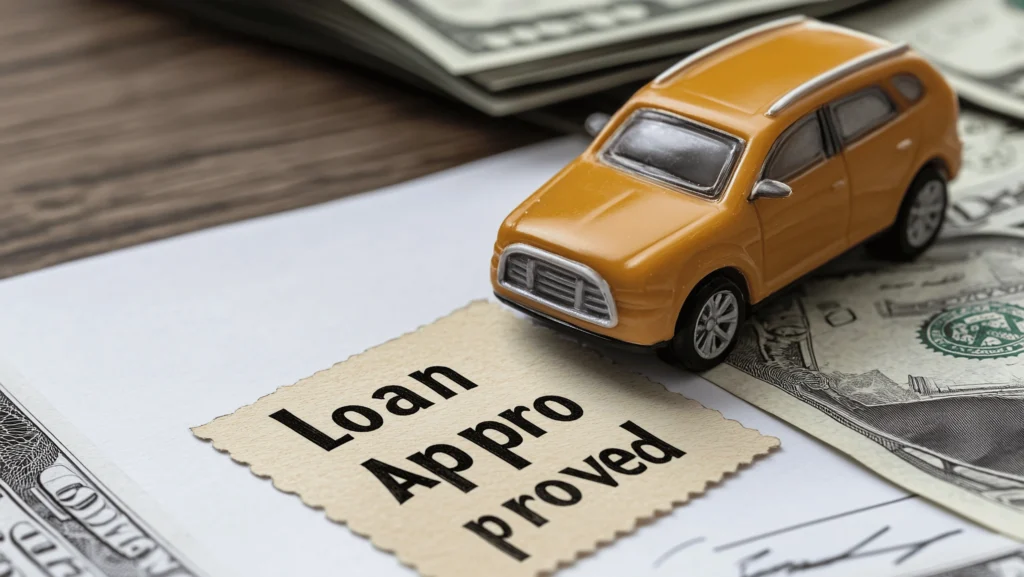1. Introduction
Buying a car is a significant financial decision, and for most people, taking out a car loan is the only way to afford one. A car loan allows you to spread out the cost of a vehicle over time, making it more manageable. However, without careful planning, you could end up paying much more than necessary due to high interest rates, hidden fees, or unfavorable loan terms.
Smart financing is essential to ensure that your car loan fits within your budget and doesn’t put unnecessary strain on your finances. By understanding how car loans work and following key money-saving strategies, you can secure the best deal, minimize interest costs, and avoid financial pitfalls.
2. Check Your Credit Score Before Applying
Before applying for a car loan, it’s crucial to check your credit score. Your credit score plays a significant role in determining the interest rate lenders will offer you. A higher credit score usually means lower interest rates, which can save you thousands of dollars over the life of the loan. On the other hand, a low credit score may lead to higher rates or even loan denial.
How Credit Scores Affect Interest Rates
- Excellent Credit (720+): Qualifies for the lowest interest rates and best loan terms.
- Good Credit (660–719): Eligible for competitive rates but slightly higher than top-tier borrowers.
- Fair Credit (600–659): May result in moderate to high interest rates.
- Poor Credit (Below 600): Likely to face very high rates, limited lender options, or the need for a co-signer.
Ways to Improve Your Credit Score Before Applying
- Check Your Credit Report for Errors – Review your credit report from agencies like Experian, Equifax, or TransUnion and dispute any inaccuracies.
- Pay Bills on Time – Late or missed payments negatively impact your score. Set up automatic payments to stay on track.
- Reduce Credit Card Balances – Lower your credit utilization ratio (below 30%) by paying down existing debts.
- Avoid Opening New Credit Accounts – Multiple credit inquiries in a short period can lower your score.
- Consider a Credit-Boosting Tool – Some services, like Experian Boost, can help improve your score by including utility and rent payments.
By taking steps to improve your credit score before applying for a car loan, you can qualify for better interest rates and save money in the long run.
3. Compare Loan Offers from Multiple Lenders
Not all car loans are the same, and different lenders offer varying interest rates, terms, and fees. To get the best deal, it’s important to compare loan offers from multiple sources before making a decision.
Banks vs. Credit Unions vs. Online Lenders
- Banks
- Offer competitive rates, especially for existing customers.
- Strict lending requirements; may require higher credit scores.
- May have slower approval processes compared to online lenders.
- Credit Unions
- Typically offer lower interest rates than banks.
- More flexible approval process, making it easier for those with fair credit to qualify.
- Membership is usually required but can be easy to obtain.
- Online Lenders
- Convenient and fast application process, often with same-day approvals.
- May offer lower rates for borrowers with excellent credit.
- Interest rates and fees can vary significantly, so careful comparison is necessary.
Importance of Shopping Around for the Best Rates
- Saves Money: Even a small difference in interest rates can save you thousands over the life of the loan.
- More Negotiation Power: Having multiple offers allows you to negotiate better terms with your preferred lender.
- Avoids Hidden Fees: Comparing loan terms helps identify unnecessary fees or unfavorable conditions.
- Increases Approval Chances: If one lender denies your application, another may approve it with better terms.
Pro Tip:
Use online loan comparison tools or get pre-approved by multiple lenders within a short period (typically 14–45 days) to avoid hurting your credit score with multiple inquiries.
4. Understand Loan Terms and Interest Rates
Understanding the terms of your car loan is essential to avoid unexpected costs. Two key factors to consider are interest rates and loan terms, which significantly impact the total amount you’ll pay over time.
Fixed vs. Variable Interest Rates
- Fixed Interest Rate:
- The interest rate remains the same throughout the loan term.
- Provides predictable monthly payments.
- Best for borrowers who prefer stability and budgeting certainty.
- Variable Interest Rate:
- The interest rate fluctuates based on market conditions.
- Initial rates may be lower than fixed rates but can increase over time.
- Suitable for borrowers who can handle payment fluctuations and are willing to take some risk.
Which is Better?
- If you want stability and predictable payments, go for a fixed rate.
- If you can tolerate some risk and want to start with a lower rate, consider a variable rate (though it’s less common for car loans).
APR vs. Interest Rate: What’s the Difference?
- Interest Rate: The cost of borrowing money, expressed as a percentage of the loan amount.
- Annual Percentage Rate (APR): Includes the interest rate plus additional lender fees, making it a better indicator of the true cost of the loan.
Why APR Matters:
- A lower interest rate does not always mean a cheaper loan—always compare APR instead.
- Some lenders offer low interest rates but charge high fees, making the total cost higher.
- Use APR to accurately compare loan offers from different lenders.
Key Takeaway:
- Choose a fixed rate if you prefer stable payments.
- Compare APR, not just the interest rate, to find the most affordable loan.
- Read the fine print to ensure there are no hidden fees that could increase your loan cost.
5. Calculate Your Budget Before Taking a Loan
Before taking out a car loan, it’s crucial to determine how much you can afford. A well-planned budget ensures that your monthly payments are manageable and don’t strain your finances.
How Much Car Can You Afford?
A good rule of thumb is the 20/4/10 rule:
- 20% Down Payment: Pay at least 20% upfront to reduce the loan amount.
- 4-Year Loan Term: Aim for a loan term of four years or less to minimize interest costs.
- 10% or Less of Monthly Income: Your total car-related expenses (loan, insurance, maintenance) should not exceed 10% of your monthly income.
To calculate affordability:
- Assess Your Monthly Income – Determine how much you can comfortably allocate to a car payment.
- Factor in Additional Costs – Consider insurance, fuel, maintenance, and registration fees.
- Use an Auto Loan Calculator – Estimate your monthly payments based on the loan amount, interest rate, and term.
Loan Term Considerations: Shorter vs. Longer Terms
| Loan Term | Pros | Cons |
|---|---|---|
| Shorter Term (3-4 years) | Lower total interest paid, faster loan payoff | Higher monthly payments |
| Longer Term (5-7 years) | Lower monthly payments, more budget flexibility | Higher total interest, risk of being “upside-down” on the loan |
Which Loan Term is Best?
- If you can afford higher monthly payments, a shorter loan term is the best choice since you’ll pay less interest.
- If you need lower payments, a longer loan term may work, but be aware of the higher overall cost.
Key Takeaways:
*Stick to the 20/4/10 rule for a financially responsible purchase.
*Consider all car-related expenses, not just the loan payment.
*Choose the shortest loan term you can comfortably afford to save on interest.
6. Make a Larger Down Payment If Possible
A larger down payment can significantly reduce the total cost of your car loan. While some lenders offer low or even zero-down-payment options, putting more money down upfront helps you save on interest and secure better loan terms.
How a Larger Down Payment Saves You Money
- Reduces the Loan Amount:
- A higher down payment means borrowing less, which leads to lower monthly payments.
- Example: If you buy a $30,000 car and put down 20% ($6,000), you only need to finance $24,000 instead of the full price.
- Lowers Interest Paid Over Time:
- Interest is calculated on the loan principal, so a smaller loan balance means paying less interest overall.
- A $25,000 loan at 6% for 5 years costs $4,000+ in interest, but a $20,000 loan at the same rate costs $3,200—a savings of $800!
- Improves Loan Approval Chances & Interest Rates:
- Lenders view a larger down payment as a sign of financial stability.
- You may qualify for a lower interest rate, reducing your total repayment cost.
- Prevents Negative Equity (“Being Upside Down”):
- Cars depreciate quickly, and a small down payment may leave you owing more than the car is worth.
- A larger down payment protects you from financial risk if you need to sell or trade in the car.
Recommended Down Payment Percentage
- New Cars: 20% or more (to offset depreciation).
- Used Cars: 10%–20% (since depreciation is lower).
- Minimum Acceptable: At least 10% to reduce interest costs and avoid negative equity.
Key Takeaways:
*A larger down payment reduces your loan amount and interest paid.
* Aim for at least 20% on new cars and 10-20% on used cars.
*A higher down payment improves loan approval chances and protects against negative equity.
7. Avoid Unnecessary Add-Ons and Fees
When financing a car, dealerships often try to increase their profits by offering add-ons and extra fees that can significantly raise the total cost of your loan. Understanding which charges are unnecessary and how to negotiate can save you money.
Common Dealership Upsells and Hidden Costs
- Extended Warranties:
- Dealers push these for extra profit, but manufacturer warranties often provide sufficient coverage.
- If you want extended coverage, consider buying it separately from a third party for a lower price.
- Gap Insurance:
- Covers the difference between your car’s value and what you owe if it’s totaled.
- It can be useful but is often cheaper through your own insurance company rather than the dealer.
- VIN Etching:
- Some dealers charge $200+ to engrave your VIN on windows as a theft deterrent.
- You can do this yourself for under $25.
- Fabric and Paint Protection:
- Often overpriced and unnecessary—many new cars already have factory protection.
- Consider using DIY or aftermarket alternatives.
- Advertising Fees & Documentation Fees:
- Some dealers add unnecessary “dealer prep,” “processing,” or “advertising” fees.
- While some doc fees are standard, excessive charges can often be negotiated down.
How to Negotiate Lower Fees
- Review the Loan Agreement Carefully: Before signing, go through every fee and ask for clarification.
- Decline Unnecessary Add-Ons: Politely refuse extras that don’t add real value.
- Negotiate or Ask for Fee Waivers: Some fees, like documentation or dealer prep fees, may be reduced or waived if you push back.
- Get Pre-Approved Elsewhere: Having pre-approval from a bank or credit union gives you leverage in negotiations.
- Be Willing to Walk Away: If a dealer insists on excessive fees, be prepared to leave—often, they’ll reconsider to keep the sale.
Key Takeaways:
*Avoid unnecessary add-ons like VIN etching, fabric protection, and overpriced warranties.
*Negotiate fees or ask for discounts to reduce your total loan cost.
*Compare insurance and warranty options elsewhere to get better deals.
8. Read the Fine Print Before Signing
Before finalizing your car loan, carefully review the loan agreement to avoid costly surprises. Some lenders include hidden fees, strict conditions, or penalties that can make your loan more expensive than expected.
Prepayment Penalties and Loan Conditions
- Prepayment Penalties:
- Some lenders charge a fee if you pay off your loan early or make extra payments.
- This protects the lender from losing interest income but costs you more in the long run.
- Tip: Choose a loan with no prepayment penalties if you plan to pay it off faster.
- Balloon Payments:
- Some loans have low monthly payments but a large lump sum due at the end.
- This can be risky if you’re not financially prepared for the final payment.
- Tip: Avoid loans with balloon payments unless you fully understand the terms.
- Variable Interest Rates:
- Some lenders offer low introductory rates that can increase over time.
- Tip: Choose a fixed-rate loan for predictable monthly payments.
Hidden Fees to Watch Out For
- Origination Fees: A one-time fee for processing your loan, often avoidable with some lenders.
- Late Payment Fees: High penalties for missing or delaying a payment.
- Loan Processing or Administrative Fees: Some lenders charge unnecessary “service fees” that should be negotiated or removed.
- Early Termination Fees: Fees for paying off the loan ahead of schedule (check for this before signing).
How to Protect Yourself
*Ask for a full breakdown of all fees before signing.
*Compare multiple lenders to find one with fair terms and no hidden costs.
*Read every clause carefully and ask questions about anything unclear.
*Negotiate or refuse fees that seem unnecessary.
Key Takeaway:
Understanding your loan agreement is just as important as getting a low interest rate. Avoid hidden fees and penalties by carefully reading the fine print before committing.
9. Consider Getting Pre-Approved for a Loan
Getting pre-approved for a car loan is a smart strategy that can save you both time and money. By securing pre-approval, you know exactly how much you can afford and can enter negotiations with confidence.
Benefits of Pre-Approval in Negotiating with Dealers
- More Leverage in Negotiations:
- When you have a pre-approved loan, the dealer knows you’re serious and financially capable.
- You can focus on the car price, rather than spending time haggling over financing terms.
- Avoids Dealer Financing Markups:
- Dealers may try to mark up financing rates for their own profit. With pre-approval, you have a better idea of the market rate, helping you spot any markup attempts.
- Tip: Use your pre-approved loan as a benchmark during negotiations to get a better deal.
- Streamlined Process:
- Pre-approval speeds up the car-buying process. Since you’ve already secured financing, you can close the deal more quickly without waiting for dealer financing approval.
How Pre-Approval Helps You Set a Realistic Budget
- Know Your Loan Amount and Interest Rate:
- Pre-approval gives you a clear understanding of how much you can borrow and the interest rate you’ll pay.
- This helps you stick to your budget and prevents you from overspending on a vehicle.
- Set a Price Range:
- Based on your pre-approved loan amount, you can confidently set a price range for the car you can afford.
- Knowing your limits prevents impulse purchases that can strain your finances.
- Avoid Overcommitting to Monthly Payments:
- Pre-approval also allows you to see the exact monthly payment you’ll be expected to make.
- This helps you choose a car that fits within your financial comfort zone without risking your ability to pay other essential expenses.
Key Takeaways:
*Get pre-approved to know your borrowing limit and interest rate before shopping.
*Use pre-approval as negotiation leverage to secure better financing terms.
*Pre-approval helps you set a realistic budget and avoid overspending on your next car.
10. Conclusion
Securing the right car loan is a critical step in making a smart, financially sound vehicle purchase. By following these tips, you can reduce your overall costs, avoid unnecessary fees, and ensure that your loan fits within your budget.
Recap of Key Tips for Securing a Smart Car Loan:
- Check Your Credit Score – Ensure you qualify for the best rates and take steps to improve it if necessary.
- Compare Loan Offers – Shop around with banks, credit unions, and online lenders to find the best deal.
- Understand Loan Terms and Interest Rates – Know the difference between fixed and variable rates, and always compare APRs to find the most affordable option.
- Calculate Your Budget – Use the 20/4/10 rule to determine how much car you can afford without straining your finances.
- Make a Larger Down Payment – The more you put down upfront, the less you’ll pay in interest and the more manageable your loan will be.
- Avoid Unnecessary Add-Ons and Fees – Be mindful of dealership upsells and hidden fees that can inflate the cost of your loan.
- Read the Fine Print – Always review the loan terms thoroughly to avoid prepayment penalties or other hidden costs.
- Consider Getting Pre-Approved – Pre-approval helps you negotiate better terms and set a realistic budget.
Encouragement to Make an Informed Decision:
By taking the time to carefully consider your options, compare lenders, and fully understand the terms of your loan, you’re empowering yourself to make an informed decision that will benefit you in the long run. Don’t rush the process—getting the best car loan for your needs will help you save money and avoid financial stress down the road.
Make sure you’re financially prepared, and drive away with peace of mind knowing you’ve made a smart choice!




